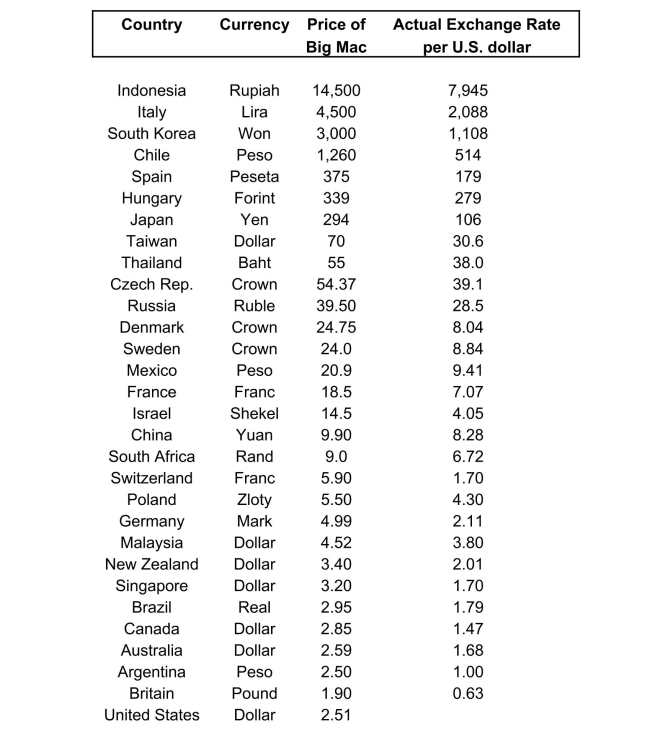(continuation with the Purchasing Power Parity question from Chapter 4)
The news-magazine The Economist regularly publishes data on the so called Big
Mac index and exchange rates between countries.The data for 30 countries from
the April 29, 2000 issue is listed below:  The concept of purchasing power parity or PPP ("the idea that similar foreign and domestic goods ... should have the same price in terms of the same currency," Abel, A. and B. Bernanke, Macroeconomics, edition, Boston: Addison Wesley, 476) suggests that the ratio of the Big Mac priced in the local currency to the U.S. dollar price should equal the exchange rate between the two countries. 16
The concept of purchasing power parity or PPP ("the idea that similar foreign and domestic goods ... should have the same price in terms of the same currency," Abel, A. and B. Bernanke, Macroeconomics, edition, Boston: Addison Wesley, 476) suggests that the ratio of the Big Mac priced in the local currency to the U.S. dollar price should equal the exchange rate between the two countries. 16
After entering the data into your spread sheet program, you calculate the predicted
exchange rate per U.S.dollar by dividing the price of a Big Mac in local currency
by the U.S.price of a Big Mac ($2.51).To test for PPP, you regress the actual
exchange rate on the predicted exchange rate.
The estimated regression is as follows: (a)Your spreadsheet program does not allow you to calculate heteroskedasticity
robust standard errors.Instead, the numbers in parenthesis are homoskedasticity
only standard errors.State the two null hypothesis under which PPP holds.Should
you use a one-tailed or two-tailed alternative hypothesis?
Correct Answer:
Verified
View Answer
Unlock this answer now
Get Access to more Verified Answers free of charge
Q23: If the errors are heteroskedastic, then
A)OLS is
Q35: (Continuation from Chapter 4, number 6)The
Q36: For the following estimated slope coefficients
Q38: Below you are asked to decide
Q39: (Continuation from Chapter 4, number 5)
Q41: Changing the units of measurement obviously
Q42: (Requires Appendix material) Your textbook shows
Q43: The neoclassical growth model predicts that
Q44: Your textbook discussed the regression model
Q59: Your textbook states that under certain restrictive
Unlock this Answer For Free Now!
View this answer and more for free by performing one of the following actions

Scan the QR code to install the App and get 2 free unlocks

Unlock quizzes for free by uploading documents